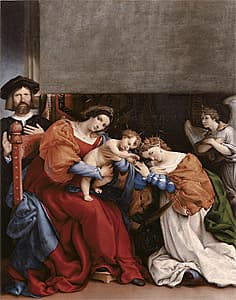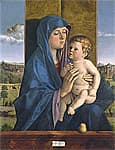Renaissance
masterclass series
Each wednesday 22 February to 28 March
6.00 – 8.00 pm
A six-week series of Masterclass lectures by key academics and experts in Renaissance art. Each lecture provides a detailed investigation of a theme, movement, work or artist featured in the exhibition. This series is ideal for enthusiasts who want to delve deeply into the rich artistic content of Renaissance. The exhibition opens exclusively to Masterclass attendees for one hour after each lecture.
$150 series, $130 members/concession (includes six lectures and exhibition entries) | bookings essential James O Fairfax Theatre and Temporary Exhibition Galleries
 Lorenzo Lotto 'The Mystic Marriage of Saint Catherine of Alexandria' [Nozze mistico di santa Caterina d'Alessandria] 1523, Accademia Carrara, Bergamo
Lorenzo Lotto 'The Mystic Marriage of Saint Catherine of Alexandria' [Nozze mistico di santa Caterina d'Alessandria] 1523, Accademia Carrara, Bergamo22 February
Dr Jaynie Anderson,
University of Melbourne, principal advisor for the exhibition
Giovanni Bellini and his Madonna paintings
This exhibition from Bergamo contains two of Giovanni Bellini’s most admired and discussed paintings of the Madonna and Child, the Lochis Madonna and the Alzano Madonna. In this lecture, Dr Anderson discusses the critical reception of Bellini's religious painting from the Renaissance until the present day, engaging with period sources such as Vasari, as well as contemporary critiques by Julia Kristeva and Leo Steinberg.
29 February
Dr Vivien Gaston,
Honorary Research Fellow, School of Culture and Communication
The Holy and the Human: Renaissance paintings from Milan
This masterclass explores the intense and intriguing visual inventions of artists working in Milan in the late fifteenth to early sixteenth centuries. We delve into the mysteries of Tarot cards, an old man with a lion, a breast-feeding Madonna, heroic saints, an elegant gentleman and a moving spiritual portrait of Christ. Leonardo da Vinci’s innovations, with their psychological impact and technical skill, had a powerful effect on Milanese artists. We review the range of traditions that inform these striking paintings and how they relate to other major works in the exhibition
7 March
Christine Dixon,
Senior Curator, National Gallery of Australia
Lotto and Renaissance painting in Northern Italy
The importance of Lorenzo Lotto in spreading the ideas of Venetian painting through Lombardy is examined, concentrating on his four works in the exhibition. Lotto's long sojourn in Bergamo influenced many artists, and heightened the artistic importance of the city in the sixteenth century.
14 March
Carl Villis,
Conservator National Gallery of Victoria.
The Shift to modern painting: Changes in artists’ materials and techniques from the Early to the Late Renaissance.
The transformation of European culture across the fifteenth and sixteenth centuries, known to all as the Renaissance, is one of the most celebrated phases in the history of art. What is less widely known is that the development of the “modern manner” of painting was accompanied by equally momentous changes in the way painters employed materials and techniques. These changes had a profound impact on the artists’ ability to produce ever more sophisticated imagery. This lecture will focus on key developments in Italy from 1450 to 1550, focusing on works in both Australian collections and the NGA’s Renaissance exhibition
21 March
Lucina Ward,
Curator, International Painting and Sculpture, National Gallery of Australia.
Art in Florence and its surrounds
The naturalism of Florentine art is much admired. This lecture explores artistic circles in and around the independent city-state, its monasteries and artist guilds, the influence of Giotto and Lippi, and the impact of the plague. Original contexts for the altarpieces and domestic works is also considered.
28 March
Dr Lisa Mansfield,
Lecturer in Art History University of Adelaide
Portraiture and Power in the Italian Renaissance
The genre of portraiture reached a high point in the fifteenth and sixteenth centuries. Not only were the materials and techniques used by artists highly sophisticated, portraiture was intimately linked to the lifestyles and reputations of the most powerful members of Italian society. This lecture considers representations of gender, class and age in order to shed light on the making, meaning and reception of Renaissance portraits as forms of non-verbal communication and persuasive instruments of power.



